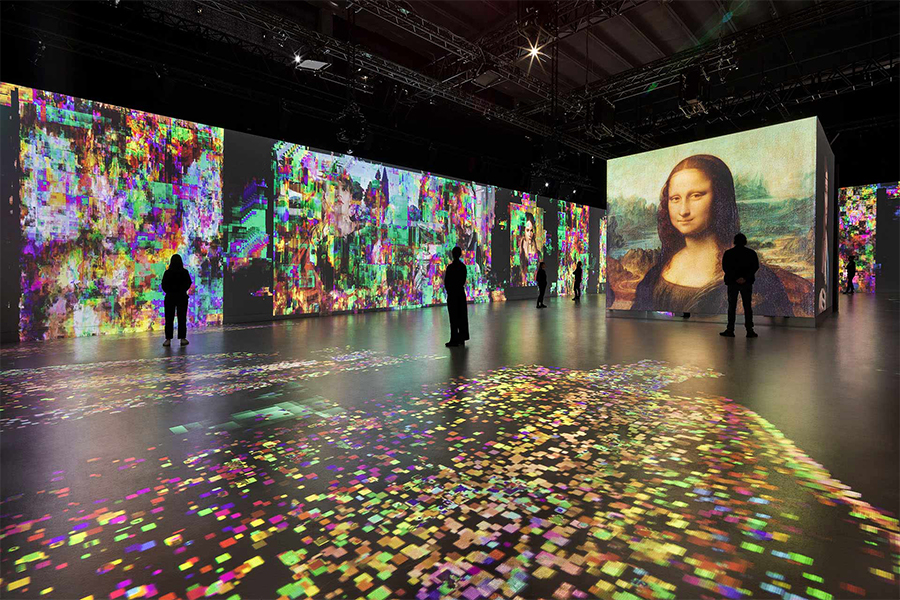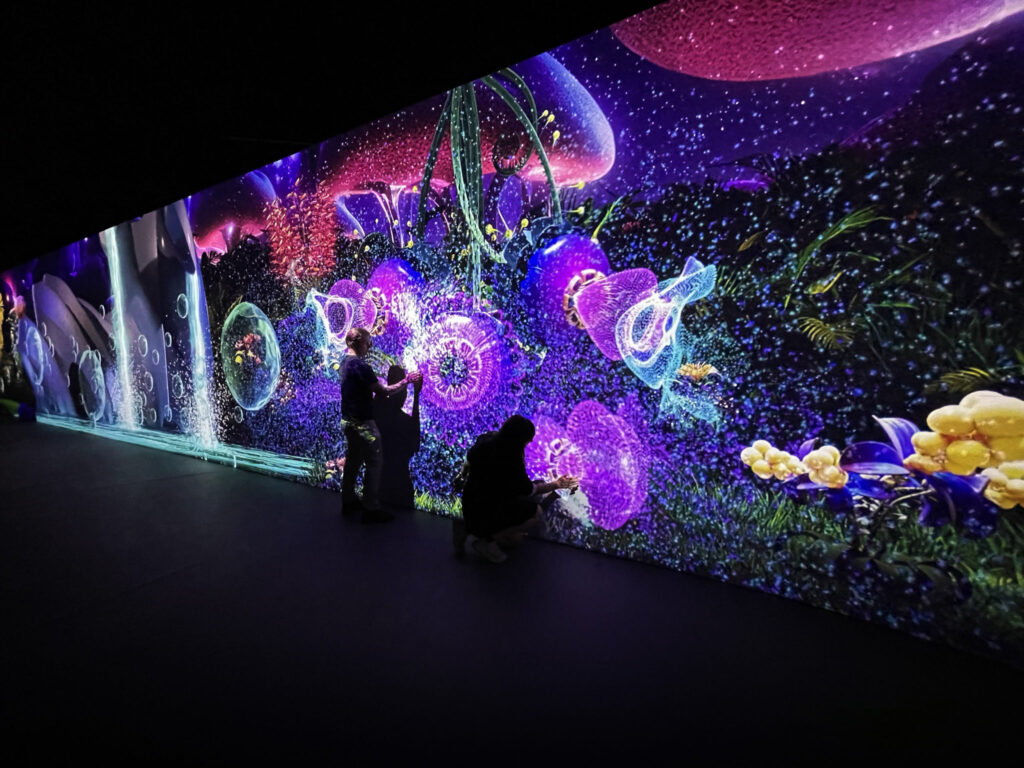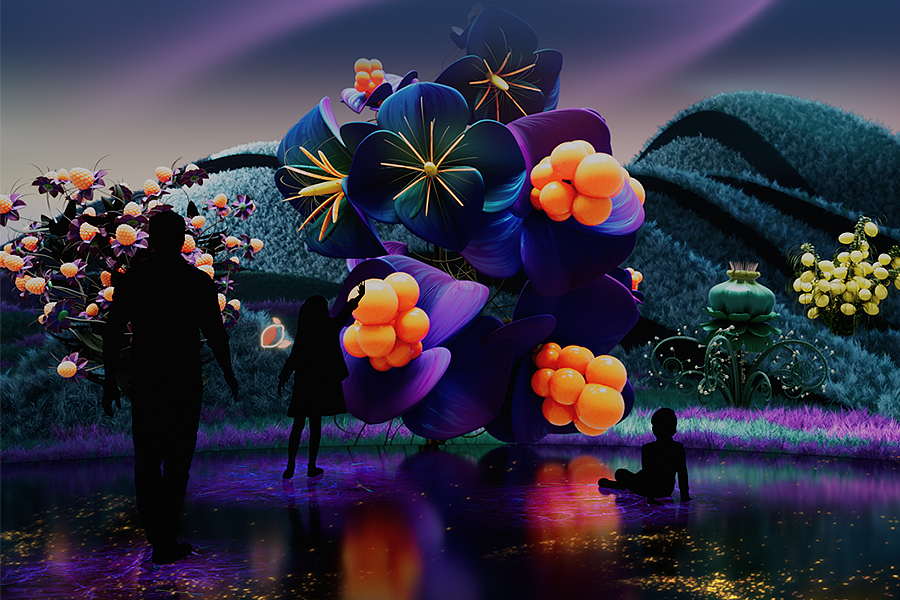We’re entering the age of storydoing.
It’s one where consumers are no longer passive watchers, but instead active protagonists who choose the storyline and impact the ending of their experience. New tech tools are also allowing experience designers to create “shared realities”: powerful moments of collective transformation based on interactivity and total immersion, where digital innovation meets real-life connection.
(For more on these trends of Storydoing, Shared Reality and New Tech Tools, watch out for the WXO’s first Future of Experiences white paper, coming soon.)
One pioneer in this area is flora&faunavisions, a boutique creative agency that designs and produces interactive, immersive experiences that move audiences across the globe. Forged in the electronic music scene of the 1990s, flora&faunavisions now work across different fields, from brand briefs to stage shows for musical artists to original IP.
But across the world and across projects, a few elements connect their work: they’re always created from the point of view of what audiences want; they embrace the naivety and boldness required to break boundaries; and they provide a shot of optimism in a sometimes dark world.
“What do you want to create? What story do you want to tell? And how are you going to do it?”
Leigh Sachwitz
In this Campfire Leigh Sachwitz, flora&faunavisions’ Founder & Principal, shares learnings from three of the studio’s trailblazing experiences: The Genius Immersive Experience, The Ring Cycle, and Utopian Garden. Expect to learn:
- How to make magic by combining storytelling fundamentals with emerging technologies
- How to create a financially and environmentally sustainable touring production
- The benefits of designing your own IP and systems
Here’s our summary of the key points of Sachwitz’s talk. To watch the full recording – or to join live Campfire events and the exclusive discussion that follows them – apply to join the WXO today.
1. How To Breathe New Life Into Legacy Art Shows

Legacy art shows are big business, and are many people’s first introduction to the world of immersive experiences. And while there’s nothing wrong with having this on-ramp, or primary, experience, a few years into the genre we need to do more than just large-scale projection mapping to breathe new life into the work of great creators.
The Genius Immersive Experience was designed to do exactly this. It creates an immersive experience around the work of Leonardo da Vinci, but through the eyes of today, bringing his life to work through live-generated content, interactive spatial design, AI, augmented reality, and a 360-degree soundscape. The story is told in chapters over a 54-minute ticketed experience for 150 visitors at a time, who can explore interactions and experience stroboscopic effects.
- Use new technology to liberate your imagination. Sachwitz was firm that she didn’t just want to blow up images of Da Vinci’s work, but wanted to take his inventions and recreate them using today’s most pioneering technology, as the great man might have if were he alive today. The result is a world of “pure imagination” – a Willy Wonka-esque play park that engages visitors in a new way. The Last Supper, for example, uses AR and AI to allow visitors to pick and transfer colours from the original painting onto a live, co-created artwork in the center of the room, which they can then take home. The Mona Lisa is remade in AR, and thanks to an immersive sound system by Sonosphere, she can whisper to guests who can only hear it if they stand close.
- Blend linear and interactive storytelling. The experience is a 50/50 mix of linear storytelling – narrative moments that guide the experience – and interactive storytelling – explorative and playful narration impacted by the audience. This is a different angle to traditional art shows that are more linear, and presents a different technical challenge to get the space running for 150 people dipping in and out of interaction. Sachwitz achieved this through a clear story and technology including 46 projectors, infrared cameras for the floors, motion trackers for the walls, and an immersive sound system, among others.
- Adapt to your space and your audience. Genius is made to tour, and can be shrunk or made bigger to adapt to different spaces. When thinking about what else to tweak when touring your production, Sachwitz starts with the audience. “At some point, you have to hand it over to the room,” she says. “We go to the shows, hang out there and watch people interact – we learn so much that way.” Secret Cinema, for example, have a two-week phase at the start of each production before they lock everything in to integrate feedback from people inside the space.
2. How To Pull Off A Digital Production On An Epic Scale
New technologies give us an opportunity to be incredibly ambitious and forge new futures for traditional artforms. Genius is one example of this, but flora&faunavisions’ adaptation of Wagner’s 15-hour operatic epic, The Ring Cycle, takes things to a whole new level.
The project took place in Brisbane, Australia, and was the world’s first-ever digital and interactive production of The Ring Cycle. Towering LED digital panels showed video triggered by the movements of 22 performers with sensors sewn into their costumes, set in time to live music. There were 124 people in the orchestra and 500 in the crew. The full 15-hour production was split into four segments that people had to buy as a full ticket (and which sold out). And the whole thing took three years to develop.
- Map out your themes and story. Figuring out the scale of themes in a colossal work like this is a challenge. Sachwitz started by creating a table of recurring themes that link to the emotions the audience would feel in their everyday lives. “At its core, emotional storytelling is about creating a sense of empathy and shared experience between the storyteller and the audience. It’s about tapping into universal human experiences and using them to create a connection between the audience and the story,” she says. She then created a five-metre-long spreadsheet mapping these themes to the timing and stage movements, giving the team a blueprint to return to. (This reminds us of the Excel sheet Secret Cinema’s Andrea Moccia used to run the epic production Arcane, or the technical documents that producer Andrew Scoville used for Theater of the Mind – proof that behind every piece of narrative art is a great spreadsheet!)
- Learn how to work with cross-disciplinary teams. Where Genius was totally concepted by flora&faunavisions, The Ring Cycle was the result of working alongside a team of incredible talents from costume designers to conductors. Sachwitz had a lot of meetings with the production’s maestro to go through pieces of video and timings alongside the music, so that it became “completely fused with what he was doing”. (For more on how to collaborate with different disciplines, check out How To Bring Different Worlds Together.) flora&faunavisions used their own digital operator and programmed and coded everything in Notch with four weeks of teching the production off-site before the premiere, to ensure it worked as flawlessly as possible.
- Use technology to reach new audiences. One of the greatest challenges with something as established as The Ring Cycle is that older and superfan audiences have high expectations, while younger audiences have less of a connection with the genre. By using technology to update the experience and also make it more accessible through touring, experiences like these can appeal to both. All the digital content from The Ring Cycle fits on one hard drive, and the LED screens and kinetic motors it relies on are standard pieces of equipment that can be rented anywhere.
3. How To Design Your Own IP
Genius was an investor-backed project for a client, and The Ring Cycle was funded by various Australian government and tourism agencies. For Utopian Garden, which ran for six months in Seattle in 2023, flora&faunavisions wanted to design a production from scratch and create a licensable, touring product of their own. “In a world filled with a sea of content, we champion the unique and the extraordinary,” says Sachwitz.
The show has a message of sustainability, channeled through making a space so beautiful and inspiring that connects you to nature through science and art, that ultimately you’re moved to take better care of your own environment and the planet at large.
- Inspire through interaction and gamification. Utopian Garden is a 45-minute immersive, story-based show where participants play through three gamified chapters driven by co-creating. In order to get to the next “level”, you have to co-create the garden with your neighbour. “Watching the guests move through the space, by the end everyone was up and interacting. Adults turned into inspired kids, playing and enjoying the space,” says Sachwitz.
- Build your own system that can be operated with ease. On a technical front, the team used software called VVVV as their predominant platform, and also integrated AI and Unreal Engine. Incredibly, they did all 928 shows in Seattle operated remotely from their studio in Berlin, with no technical issues and amazing stability. This technical setup was also designed to be available anywhere and for teams that don’t have to be highly skilled to operate it – it only requires one AV technician, one FOH staff in the room, and two in accreditation.
- Provide a malleable space for integration and education. After the main experience has finished, participants at Utopian Garden are led into a low-key workshop area where they can have a shared experience and create, talk, and be vulnerable together. This space can be customised according to the market you’re in, and transforms into a multifunctional event space for things like partner events, gaming, or even an outdoor garden. As well as providing a reflection space – a key element of the trilogy of anticipation, participation and reflection – this space can therefore also make the experience more commercially viable.
The WXO Take-Out

We’re at an incredibly exciting point for experience design – and the work that flora&faunavisions are doing provides an inspiring blueprint for how to combine digital innovation and classic storytelling techniques and experience design frameworks to not only create sustainable experiences, but move audiences to experience art, culture and nature in a deeper way.
We’re most struck by the flexibility of their designs and ideas, with productions that can be scaled up or down, toured between destinations, and customised for different audiences – and to reach new ones. As we all grapple with the question of how to best scale our experiences while maintaining artistic integrity, experiences such as these suggest some potential routes forward.
So next time you’re designing an experience, ask yourself:
- How might you make your experience fit to tour?
- How might you blend linear and interactive storytelling?
- What technologies might you experiment with to breathe new life into your format?
Want to come to live Campfires and join fellow expert experience creators from 39+ different countries as we lead the Experience Revolution forward? Find out how – and the current speaker line-up – here.






